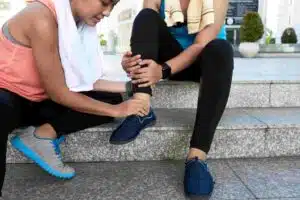
- Home
- About
- Services
- Conditions
- Symptoms
- Patients
- Reviews
- Contact

One wrong step, one awkward landing, and suddenly, you're out of the dance shoes and onto the sidelines. For dancers, even a small injury can feel like a major setback to expression, progress, and confidence.
But recovery from a dance injury doesn't mean the end of your journey; it's a chance to heal smarter, stronger, and safer. With the proper treatment and support, you can find your rhythm again and return to dance with confidence.
This guide walks you through everything you need to know about common dance injuries and treatment, from understanding the cause to finding effective care and preventing future setbacks.
Dance is both an art and a physical sport, which means injuries can happen, especially with repetitive movements and high-impact routines. Most dancers face these challenges regularly, making awareness and injury prevention essential.
 Sprains and strains: These often result from quick turns, unstable landings, or overstretching, especially in the ankles, knees, and wrists.
Sprains and strains: These often result from quick turns, unstable landings, or overstretching, especially in the ankles, knees, and wrists.A dance injury doesn't close the curtain; it's just a detour. Here's a simple, step-by-step guide to help you recover safely and get back on your feet.
Effective recovery starts with an accurate diagnosis from a qualified healthcare provider, such as a chiropractor, rehabilitation specialist, or sports medicine doctor for dancers.
These professionals assess injuries through movement evaluations, physical exams, and imaging, like X-rays or MRIs. Finding the root cause builds clarity around your care plan and ensures treatments support safe, lasting recovery.
No two injuries—and no two dancers—are the same. That's why your care plan must reflect your unique goals, physical demands, and stage of recovery.
Your treatment may include chiropractic adjustments to restore joint function, physiotherapy to rebuild strength and flexibility, or pain relief strategies that support your return to movement.
The initial phase focuses on reducing inflammation, relieving pain, and beginning gentle stretches that keep your body engaged without straining injured areas.
Rest matters, but so does movement. Too much inactivity can slow healing, while guided, low-impact movement supports circulation and preserves the range of motion.
As recovery moves forward, it’s less about rest and more about rebuilding, helping your muscles support you again, steadying your joints, and restoring full-body coordination.
You'll retrain foundational movement patterns, like proper landings and posture corrections, to reduce the risk of reinjury and enhance overall performance.
Rejoining your dance class or company after an injury takes patience, self-compassion, and steady support. It’s normal to feel eager and a little nervous as you return to movement. Ease back into rehearsals with modified choreography, slower pacing, and breaks when needed.
Your care team will help you transition with confidence, offering reassurance and adjustments, reducing the risk of setbacks. With a thoughtful plan and consistent encouragement, you'll return to the dance community feeling stronger, more grounded, and more confident in your body’s renewed strength.
Injury prevention for dancers goes beyond technique; it's about taking proactive steps to protect your body before issues arise. These strategies can help you stay resilient and avoid setbacks that could take you off the stage.
Before you dive into movement, give your body a moment to prepare. Warming up prepares your muscles, joints, and cardiovascular system to move, while cooling down supports recovery after intense activity. Both are essential for preventing dance injuries and easing post-dance muscle stiffness and soreness.
Building strength around your joints, especially the knees, ankles, hips, and core, helps absorb impact and gives you better control during demanding routines. This added support significantly reduces your risk of strain, sprain, or acute injury during demanding routines.
Maintaining proper posture enhances balance, technique, and efficiency of movement. Consistent alignment also keeps unnecessary stress off your joints and muscles, lowering your risk of overuse injuries.
Your body needs fuel, fluid, and rest to perform and heal. Eating well, staying hydrated, and getting enough sleep help your muscles repair and your energy levels stay optimal. These foundational habits keep your body ready to meet the physical demands of dance.
You don’t have to navigate recovery or prevention alone. Regular visits with providers who understand dance, such as a chiropractor in Burbank or an orthopedic specialist for dancers, can help spot minor issues before they become major setbacks.
Don't ignore pain or unusual symptoms. If “dance physical therapy near me” has been on your search list, these signs may mean it's time to consult a professional:
Early intervention leads to faster, safer recovery.
At Allied Pain and Wellness in Burbank, we help dancers recover with care specifically for your lifestyle and needs. Led by Dr. Shahen Simian, an experienced chiropractor who understands the physical and emotional journey of movement and recovery, the practice offers expert care in a supportive environment.
For a dancer, being told to stop dancing isn’t just frustrating; it can feel like losing part of yourself. But with the right care, you can rebuild and return to movement with strength and confidence.
At Allied Pain and Wellness in Burbank, we understand how much movement means to you. Our team provides reliable, personalized care to help you heal, regain strength, and feel ready to step back into the studio with ease. Schedule your consultation today and take your first step toward dancing freely and safely again!

Monday: 9:00am-7:00pm
Tuesday: 9:00am-7:00pm
Wednesday: 9:00am-7:00pm
Thursday: 9:00am-7:00pm
Friday: 9:00am-7:00pm
Saturday: 9:00am-2:00pm
Sunday: Closed